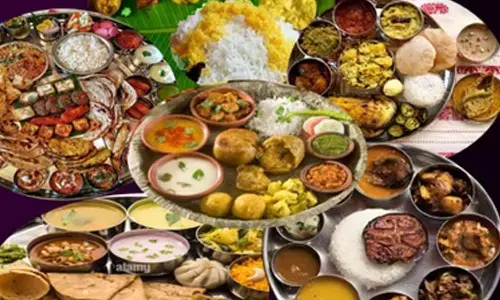The many varieties of humour

I had introduced the readers, in an earlier piece in this column, dealing with letter writing, to an uncle of mine who was in all senses of the expression, a ‘jolly good fellow’.
I had introduced the readers, in an earlier piece in this column, dealing with letter writing, to an uncle of mine who was in all senses of the expression, a 'jolly good fellow'. So boisterous and loud was his laughter that people entering Guntur town (where he worked for a tobacco company), would know he was available in town, in a manner of speaking, just by hearing his laughter from the Club, even as they reached the outskirts! He carried joy and cheer with them wherever he went.
My father also had an incisive and sharp sense of humour, and was known for his wit while he served on the Bench of the Andhra Pradesh High Court as a Judge.He chose, as advice to me, as I entered my career and married life, the simple words, 'be happy'. He believed that unhappy persons were a drag on society and that the objective of life should be to be productive, and to be of use to others, especially those in need.
We are a family, in fact a 'khandaan', of short people. Among us, being of a height of about 149 cm is accepted as 'tall'. Murthy, my elder brother was particularly short. He related to me an event from the days he was an intermediate (the bridge course, of two years, between school and college, in those days) student in Loyola College, Madras (now Chennai).
He was attending an English class when, after reading a particularly funny passage from a novel by P.G. Wodehouse (PGW), he burst into a paroxysm of laughter. Upon being asked by an angry lecturer to stand up, he compiled. In spite of that, "I said stand-up Murthy!", roared the lecturer. Given the short stature, the lecturer has failed to notice that my brother was already standing!
Incidentally, Wodehouse is easily the most favourite humorous author of mine. Not only have I read most of the more than 80 novels authored by him, but also had the pleasure, once recently, of participating in a discussion, in a club, the members of which discuss in groups the works of this 'performing flea of English literature', as the Irish dramatist and memoirist, Sean O'Casey described him.
PGW's books have been translated into many languages in the world, and I had the honour, sometime ago, of releasing a translation into Telugu of his famous novel' The Old Reliable'. I have also read with great pleasure, and joy, many of the works of other suave practitioners of wit and humour such as Henry Cecil, Stephen Leacock, Mark Twain, Groucho Marx and travelogue specialist Bill Bryson.
Laughter, as is widely accepted, is the best way of expressing a state of happiness and contentment. The oft quoted ancient Latin adage goes, 'laugh and the world laughs with you, weep and you weep alone'. Laughter and amusement are best provoked by humour, in people of all ages, and everywhere in the world. One rarely finds persons incapable of appreciating a joke, or laughing at a funny or absurd situation. The ability to be amused or laugh, known as a sense of humour, is almost a universal attribute.
There are many theories of humour which attempt to explain what it is, what functions it serves and what would be humorous. Most of them consider humour to be very healthy behaviour. The 'Relief' Theory, for instance, says that humour reduces psychological tension and facilitates release of the impact of fears. Laughter and mirth result from the release of nervous energy.
The 'Superiority' Theory, on the other hand, says that a person laughs about the misfortune of others because those misfortunes assert the person's superiority. Professor of Psychology Peter McGraw postulated the 'Benign – Violation' Theory, according to which humour pertains to something which is "…..wrong, unsettling or threatening, …… but seems okay, acceptable or safe".
Humour, has, in fact, been accorded the status of one of the nine Navarasas (nine emotional responses), which can be inspired in audiences, by performers, in 'Natya Sastra', or the science of dance, in ancient Sanskrit drama. And veteran artists have perfected the art of 'self-deprecation', which substantially increases the rapport between the performance and the audience.
Philosophers belonging to the school of 'Stoicism' recommended it as a response to insults, as joining the critics removes the sting from the intended insult. In traditional British – English culture it is considered an element of modesty, and a virtue that demonstrates self-confidence. Belittling oneself is to be polite by putting someone else first.
No doubt, personal taste plays an important role in the manner in which a sense of humour manifests itself in a person, and depends on a number of variables, including geographical location, culture, level and intelligence.For example some people, especially children, prefer the 'slapstick' variety of humour, while others like it presented in a restrained and understated fashion.
Humour has many beneficial effects, including the ability to defuse tension in a situation by taking away the awkward, or uneasy, feeling between and amongst persons and facilitates smooth interaction.
It is for these reasons that, throughout history, comedy has been used as a form of entertainment, all over the world, from the Courts of Kings to street shows in villages. It A sense of humour has also been known to be an important element of the chemistry that attracts young men and women to each other. Newspapers and periodical magazines, invariably provide a special place for humorous cartoons and snippets. I still recollect, with great nostalgia and joy, items such as 'Laughter The Best Medicine', 'Humour in Uniform', in the Readers' Digest, columns such as 'Knockout' (which always ended with the question 'do you get me Steve'?), by the sensationally popular 'Bobby' (A.F.S.),Talyar Khan, mostly in the widely read Blitz, and 'With Malice Towards One and All' by the inimitable Khushwant Singh in many newspapers including the highly popular Illustrated Weekly of India. And nearly all dailies carried a front-page cartoon by a famous cartoonist such as the maestros of humorous cartoons like R.K. Laxman, Mario Miranda and Abu Abraham. Events like circuses, plays and movies always leave space for comedy and humour by way of relief from the otherwise serious main show.
While every language has had its more than just share of wits, satirists, cartoonists and the like, I am tempted to mention here the names of the legendary duo Bapu and Ramana, who in a dazzling career of over 40 years, regaled Telugu audiences all over the world with their cartoons and stories.
Some of the movies produced by them were also masterpieces of finesse and subtlety. Ramana, in fact, was hailed as the P. G. Wodehouse for Telugu literature. Another Telugu cartoonist and humourist, widely known for his significant contribution, was 'Bujjai', whose memorable contributions included, among other things, creating the comic series 'Panchtantra'. Care has to be taken, however, not to approach humour with a rigid and analytical bent of mind which is sure to destroy its very essence.
(The writer is former Chief Secretary, Government of Andhra Pradesh)
(The opinions expressed in this column are that of the writer. The facts and opinions expressed here do not reflect the views of The Hans India)













